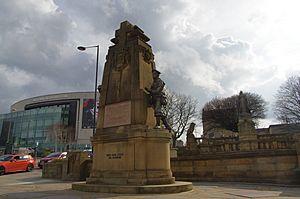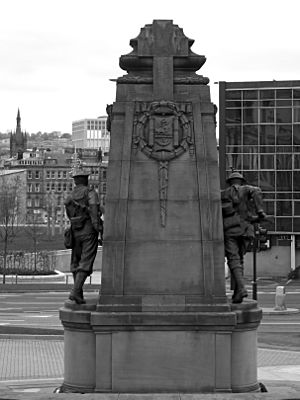Bradford War Memorial facts for kids

The Bradford War Memorial is a special monument in Bradford, England. It remembers the 37,000 brave men from the city who served in the British Armed Forces during the First World War. Sadly, about 5,000 of them died. Many of these soldiers were part of the "Bradford Pals" battalions. They faced a very tough battle on July 1, 1916, during the Battle of the Somme.
This important stone monument, with its bronze statues, was officially revealed on July 1, 1922. It stands in Victoria Square, close to the National Science and Media Museum and the Alhambra Theatre, Bradford. After the Second World War, a bronze plaque was added to also remember those who died in that conflict and other wars since. The memorial was recognized as a Grade II listed building in 2016, meaning it's a historically important structure.
Contents
What Does the Memorial Look Like?
The Bradford War Memorial was designed by Walter Williamson, who was Bradford's city architect. The sculptures were made by a company called HH Martyn and Co.
The Main Stone Tower
The memorial has a tall, central stone tower called a pylon. It's about 4.35 meters (around 14 feet) high and gets narrower towards the top. This stone came from a nearby place called Bolton Woods. On top of the pylon is a stone sarcophagus, which looks like a coffin.
Special Carvings
Both the front and back of the pylon have a carved cross. The bottom part of the cross looks like a sword blade going through a wreath (a circle of leaves). On the front, the wreath has a scroll that says "PRO PATRI MORI," which is Latin for "For the Fatherland, they died." The sides of the pylon have a winged wreath with the letters "RAF" on them. The whole pylon stands on an oval platform with steps leading down to the road.
The Bronze Statues
Two bronze statues stand on the steps, one on each side of the main stone tower. On the left is a soldier, and on the right is a sailor. Both are shown leaning forward, holding a rifle. These statues were created by Robert Lindsey Clark, a lead sculptor at HH Martyn and Co Ltd.
A Bit of History About the Statues
When the memorial was first shown, some people thought the soldiers' fighting pose was too strong. Originally, their rifles had long bayonets (knives attached to the end of the rifle). In 1969, these bayonets were damaged and later removed, but you can still see where they were attached.
What Do the Inscriptions Say?
The front of the pylon originally had a long message. It honored the men of Bradford who served in the Great War (1914-1918) and said the memorial was put up by their fellow citizens. It also mentioned the date it was unveiled, July 1, 1922, and who unveiled it.
Updated Message for All Conflicts
In 1969, a bronze plaque was added over this original message. This new plaque remembers those who served in the Second World War (1939-1945) and other conflicts since then. It now reads: "TO THE IMMORTAL HONOUR OF / THE MEN AND WOMEN OF THE / CITY OF BRADFORD / WHO SERVED THEIR KING AND EMPIRE / 1914 - 1918 1939 - 1945/ AND IN OTHER CONFLICT / IN PROUD AND/ GRATEFUL REMEMBRANCE". Below this, the base still has the original words: "THEIR NAME LIVETH FOR EVERMORE".
The Bradford Pals and the Somme
During the First World War, two special groups of soldiers, called "pals battalions", were formed in Bradford. These were the 16th and 18th Battalions of the Prince of Wales's Own (West Yorkshire Regiment). Many men from Bradford joined these groups, often with their friends and neighbors.
A Difficult Day at the Somme
These battalions served in Egypt and then on the Western Front in France. On July 1, 1916, about 2,000 men from Bradford went "over the top" (meaning they climbed out of their trenches to attack) at a place called Serre. This was on the first day of the Battle of the Somme, one of the deadliest battles in history. Sadly, almost 1,800 of them were killed or wounded that day. The battalions were later rebuilt with new recruits and continued to fight until 1918.
The Unveiling Ceremony
The Bradford War Memorial was officially unveiled on Saturday, July 1, 1922. This date was chosen because it was exactly six years after the start of the Battle of the Somme. A huge crowd of 40,000 people gathered to watch the ceremony.
Important People at the Event
The memorial was unveiled by Lieutenant-Colonel Alderman Anthony Gadie. He was a former Lord Mayor of Bradford and later became a Member of Parliament for Bradford. The dedication ceremony was led by the Archdeacon of Bradford, William Stanton Jones.
Images for kids





